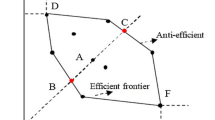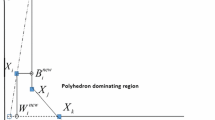Abstract
This paper proposes an approach to the cross-efficiency evaluation that considers all the optimal data envelopment analysis (DEA) weights of all the decision-making units (DMUs), thus avoiding the need to make a choice among them according to some alternative secondary goal. To be specific, we develop a couple of models that allow for all the possible weights of all the DMUs simultaneously and yield individual lower and upper bounds for the cross-efficiency scores of the different units. As a result, we have a cross-efficiency interval for the evaluation of each unit. Existing order relations for interval numbers are used to identify dominance relations among DMUs and derive a ranking of units based on the cross-efficiency intervals provided. The approach proposed may also be useful for assessing the stability of the cross-efficiency scores with respect to DEA weights that can be used for their calculation.




Similar content being viewed by others
References
Adler N, Friedman L and Sinuany-Stern Z (2002). Review of ranking methods in the data envelopment analysis context. European Journal of Operational Research 140 (2): 249–265.
Campos L and Muñoz A (1989). A subjective approach for ranking fuzzy numbers. Fuzzy Sets and Systems 29 (2): 145–153.
Charnes A and Cooper WW (1962). Programming with linear fractional functionals. Naval Research Logistics Quarterly 9 (3–4): 181–186.
Charnes A, Cooper WW and Rhodes E (1978). Measuring the efficiency of decision making units. European Journal of Operational Research 2 (6): 429–444.
Chen TY (2002). An assessment of technical efficiency and cross-efficiency in Taiwan's electricity distribution sector. European Journal of Operational Research 137 (2): 421–433.
Dotoli M and Falagario M (2012). A hierarchical model for optimal supplier selection in multiple sourcing contexts. International Journal of Production Research 50 (11): 2953–2967.
Doyle JR and Green RH (1994). Efficiency and cross-efficiency in DEA: Derivations, meanings and uses. Journal of the Operational Research Society 45 (5): 567–578.
Dubois D and Prade H (1980). Systems of linear fuzzy constraints. Fuzzy Sets and Systems 3 (1): 37–48.
Entani T, Maeda Y and Tanaka H (2002). Dual models of interval DEA and its extension to interval data. European Journal of Operational Research 136 (1): 32–45.
Entani T, Sugihara K and Tanaka H (2006). Interval evaluations in DEA and AHP. Studies in Fuzziness and Soft Computing 201: 291–304.
Falagario M, Sciancalepore F, Costantino N and Pietroforte R (2012). Using a DEA-cross efficiency approach in public procurement tenders. European Journal of Operational Research 218 (2): 523–529.
Freeling ANS (1980). Fuzzy sets and decision analysis. IEEE Transactions on Systems, Man and Cybernetics 10 (7): 341–354.
Friedman L and Sinuany-Stern Z (1998). Combining ranking scales and selecting variables in the DEA context: The case of industrial branches. Computers and Operations Research 25 (9): 781–791.
Ishibuchi H and Tanaka H (1990). Multiobjective programming in optimization of the interval objective function. European Journal of Operational Research 48 (2): 219–225.
Lahdelma R and Salminen P (2001). SMAA-2: Stochastic multicriteria acceptability analysis for group decision making. Operations Research 49 (3): 444–454.
Liang L, Wu J, Cook WD and Zhu J (2008). Alternative secondary goals in DEA cross-efficiency evaluation. International Journal of Production Economics 113 (2): 1025–1030.
Lu WM and Lo SF (2007). A closer look at the economic-environmental disparities for regional development in China. European Journal of Operational Research 183 (2): 882–894.
Mavrotas G and Trifillis P (2006). Multicriteria decision analysis with minimum information: Combining DEA with MAVT. Computers and Operations Research 33 (8): 2083–2098.
Ramón N, Ruiz JL and Sirvent I (2010). On the choice of weights profiles in cross-efficiency evaluations. European Journal of Operational Research 207 (3): 1564–1572.
Ramón N, Ruiz JL and Sirvent I (2011). Reducing differences between profiles of weights: A ‘peer-restricted’ cross-efficiency evaluation. Omega 39 (6): 634–641.
Sexton TR, Silkman RH and Hogan AJ (1986). Data envelopment analysis: Critique and extensions. In RH Silkman (ed). Measuring Efficiency: An Assessment of Data Envelopment Analysis. Jossey-Bass: San Francisco, CA 73–105.
Shang J and Sueyoshi T (1995). A unified framework for the selection of a flexible manufacturing system. European Journal of Operational Research 85 (2): 297–315.
Wang X and Kerre EE (2001). Reasonable properties for the ordering of fuzzy quantities (I). Fuzzy Sets and Systems 118 (3): 375–385.
Wang YM and Chin KS (2010a). A neutral DEA model for cross-efficiency evaluation and its extension. Expert Systems with Applications 37 (5): 3666–3675.
Wang YM and Chin KS (2010b). Some alternative models for DEA cross-efficiency evaluation. International Journal of Production Economics 128 (1): 332–338.
Wang YM, Chin KS and Wang S (2012). DEA models for minimizing weight disparity in cross-efficiency evaluation. Journal of the Operational Research Society 63 (8): 1079–1088.
Wu J, Liang L and Yang F (2009). Achievement and benchmarking of countries at the Summer Olympics using cross-efficiency evaluation method. European Journal of Operational Research 197 (2): 722–730.
Yang F, Ang S, Qiong X and Yang C (2012). Ranking DMUs by using interval DEA cross efficiency matrix with acceptability analysis. European Journal of Operational Research 223 (2): 483–488.
Zhu J (1998). Data envelopment analysis vs. principal component analysis: An illustrative study of economic performance of Chinese cities. European Journal of Operational Research 111 (1): 50–61.
Author information
Authors and Affiliations
Corresponding author
Appendix
Appendix
Proof of proposition
Let  be a point in the interval
be a point in the interval  then
then  for some λ∈[0, 1]. Let (v
d
R, u
d
R), d=1, …, n, be an optimal solution of (5), and (v
d
L, u
d
L), d=1,…,n, an optimal solution of (8). We assume, without loss of generality, both that
for some λ∈[0, 1]. Let (v
d
R, u
d
R), d=1, …, n, be an optimal solution of (5), and (v
d
L, u
d
L), d=1,…,n, an optimal solution of (8). We assume, without loss of generality, both that  and
and  Thus, we have that
Thus, we have that  and
and  Consider the following vectors
Consider the following vectors  where
where  and
and  Then, for every j=1, …, n, we have
Then, for every j=1, …, n, we have

and it is also satisfied

Therefore,  are optimal solutions of the CCR model for DMU
d
, d=1, …, n, respectively. In addition,
are optimal solutions of the CCR model for DMU
d
, d=1, …, n, respectively. In addition,

Rights and permissions
About this article
Cite this article
Ramón, N., Ruiz, J. & Sirvent, I. Dominance relations and ranking of units by using interval number ordering with cross-efficiency intervals. J Oper Res Soc 65, 1336–1343 (2014). https://doi.org/10.1057/jors.2013.90
Received:
Accepted:
Published:
Issue Date:
DOI: https://doi.org/10.1057/jors.2013.90




